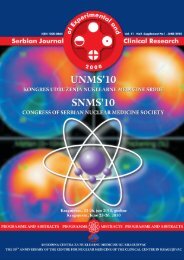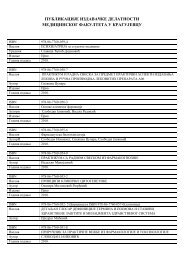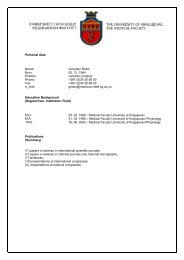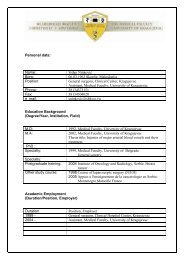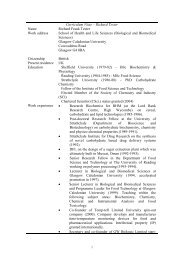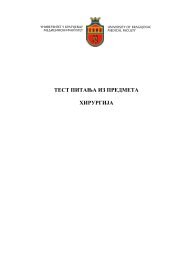Untitled - Medicinski fakultet Kragujevac - Univerzitet u Kragujevcu
Untitled - Medicinski fakultet Kragujevac - Univerzitet u Kragujevcu
Untitled - Medicinski fakultet Kragujevac - Univerzitet u Kragujevcu
You also want an ePaper? Increase the reach of your titles
YUMPU automatically turns print PDFs into web optimized ePapers that Google loves.
the contralateral heel strike. This is followed by a continuous<br />
curve increase, marked as the toe-off point in the next<br />
maximum. From the local maximum, the motion curve<br />
extends almost horizontally, denoting the swing phase, after<br />
which the decline to the next local minimum begins,<br />
labelled as the new heel strike of the same leg. The values<br />
that define shift of the tibia relative to the femur are given<br />
s a function of time, e.g., defined as a percentage of the gait<br />
cycle relative to time.<br />
For indirect determination of the AP-tibia translation,<br />
we monitored the differences in the distance between LEF<br />
and TT points (Fig. 3) in space and in the sagittal plane, as<br />
well as the tibia shift along the AP axis. The shortest distance<br />
between LEF and TT points was determined using collected<br />
data for markers positions in space from .c3d file, such as:<br />
- the spatial distance between LEF and TT<br />
Figure 2. Th e key functional gait phases of the motion curve of the ankle joint centre<br />
and<br />
- the distance between LEF and TT in the sagittal plane<br />
where x is the AP direction and z is the superior–inferior<br />
direction.<br />
Based on the definitions of the distance between LEF<br />
and TT in space and in the relevant planes, differences in<br />
length are determined as:<br />
- the spatial difference in the lengths of the distance between<br />
LEF and PP<br />
and<br />
- the difference in lengths of the distance between LEF and<br />
PP in the sagittal plane<br />
LEF -lateral epycondil of the femur,<br />
TT- tuberosity of the tibia,<br />
PDP - distance between LEF and TT points in space,<br />
DPHR - distance between LEF and TT points in horizontal plane,<br />
DPSR - distance between LEF and TT points in sagittal plane, and<br />
DPFR - distance between LEF and TT points in frontal plane.<br />
Figure 3. Identifi cation of the distances between LEF and TT in space<br />
and in the horizontal, frontal and sagittal planes<br />
The tibia shift along the AP direction (Fig. 4) is determined<br />
by successive calculations of the affine coordinates<br />
along these directions:<br />
The angle of the IE rotation is determined based on definition<br />
of the tangent line coefficient of the movement curve<br />
and on the definition of the angle between the tangent line<br />
and AP axis of the femoral coordinate system (Fig. 5) [7].<br />
During the motion, the femoral coordinate system is considered<br />
the referent coordinate system that does not change its<br />
orientation. On the other side, IE tibia rotation occurs during<br />
motion. During the motion, i.e., within the stride (point P1)<br />
(Fig. 5), the tibia rotates at a certain angle relative to femoral coordinate<br />
system. On the tibial motion curve at point P1, in this<br />
particular moment within the gait cycle, it is possible to define<br />
51





